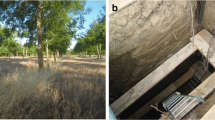Abstract
A study was carried out in an alley cropping system in the Eastern Maize Belt of the United States with the objective of quantifying the competition for water between trees (black walnut (Juglans nigra L.) and red oak (Quercus rubra L.) and maize (Zea mays L.). Spatial and temporal variation in soil moisture, tree and maize rooting patterns, tree and maize water uptake, and maize leaf area expansion were determined in three treatments; ‘barrier’ (polyethylene root barriers separating maize and tree roots), ‘trench’ (trenching without a polyethylene barrier), and ‘no barrier’ (control). Significant temporal variation in soil moisture was observed in both black walnut and red oak alley cropping systems. The ‘barrier’ and ‘trench’ treatments resulted in higher soil moisture in the ‘maize alley’ and lower soil moisture in the ‘tree row’ than the ‘no barrier’ treatment. Uptake of water by maize was higher in the ‘barrier’ than the ‘no barrier’ treatment. However, tree water uptake was higher in the ‘no barrier’ treatment than in the ‘barrier’ treatment because tree roots utilized water from the ‘maize alley’. Maize leaf area was negatively impacted by water stress in the ‘no barrier’ treatment. Quantification of rooting patterns revealed that maize and tree roots were concentrated in the top 30 cm soil layer where water fluctuations were greatest. The ‘barrier’ and ‘trench’ treatments successfully eliminated the belowground root competition between trees and maize and resulted in greater leaf area and higher grain yields than the ‘no barrier’ treatment. Thus, competition for water rather than competition for light seems to be critical in defining the productivity and sustainability of this alley cropping system.
Similar content being viewed by others
References
Atkinson D (1980) The distribution and effectiveness of the roots of tree crops. Hort Review 2: 424–490
Begg JE and Turner NC (1976) Crop water deficits. Adv Agron 28: 161–217
Cienciala E and Lindroth A (1995) Gas-exchange and sap flow measurements of Salix vimi-nalis trees in short-rotation forest. I. Transpiration and sap flow. Trees 9: 289–294
Garrett HE and Buck LE (1997) Agroforestry practice and policy in the United States of America. For Ecol Manage 91: 5–15
Garrett HE and Kurtz WB (1983) Silvicultural and economic relationships of integrated forestry-farming with black walnut. Agrofor Syst 1: 245–256
Gavloski JE, Whitfield GH and Ellis CR (1992) Effect of restricted watering on sap flow and growth in corn (Zea mays L). Can J Plant Sci 72: 361–368
Gillespie AR (1989) Modelling nutrient flux and interspecies root competition in agroforestry interplanting. Agrofor Syst 8: 257–266
Gillespie AR, Jose S, Mengel DB, Hoover WL, Pope PE, Seifert JR, Biehle DJ, Stall T and Benjamin TJ (2000) Defining competition vectors in a temperate alley cropping system in the midwestern USA: 1. Production physiology. Agrofor Syst 48: 25–40
Govindarajan M, Rao MR, Mathuva MN and Nair PKR (1996) Soil-water and root dynamics under hedgerow intercropping in semiarid Kenya. Agron J 88: 513–520
Howard SB, Ong CK, Rao MR, Black CR and Khan AAH (1997) Using sap flow gauges to quantify water uptake by trees roots from beneath the crop rooting zone in agroforestry systems. Agrofor Syst 35: 15–29
Hsiao TC (1973) Plant responses to water stress. Annu Rev Plant Physiol 24: 519–570
Jonsson K, Fidjeland L, Maghembe JA and Högberg P (1988) The vertical distribution of fine roots of five tree species and maize in Morogoro Tanzania. Agrofor Syst 6: 63–69
Jose S and Gillespie AR (1998) Allelopathy in black walnut (Juglans nigra L.) alley cropping: I. Spatio-temporal variation in soil juglone in a black walnut – corn (Zea mays L.) alley cropping system in the midwestern US. Plant Soil 203: 191–197
Klepper B (1991) Root-shoot relationships. In: Waisel Y, Eshel A and Kafkafi U (eds) Plant roots: The hidden half, pp 265–286. Marcel Dekker, New York
Little TM and Hills FJ (1978) Agricultural experimentation. John Wiley and Sons, New York, 350 pp
Mc Kee GW (1964) A coefficient for computing leaf area in hybrid corn. Agron J 56: 240–247
NeSmith DS and Ritchie JT (1992a) Effects of soil water deficits during tassel emergence on development and yield component of maize (Zea mays). Field Crops Res 28: 251–256
NeSmith DS and Ritchie JT (1992b) Short-and long-term responses of corn to pre-anthesis soil water deficit. Agron J 84: 107–113
Noweg TA and Kurtz WB (1987) Eastern black walnut plantations: an economically viable option for conservation reserve lands within the corn belt. North J Appl For 4: 158–160
Ong CK, Corlett JE, Singh RP and Black CR (1991) Above and belowground interactions in agroforestry systems. For Ecol Manage 45: 45–57
Robertson MJ (1994) Relationships between internode elongation plant height and leaf appear-ance in maize. Field Crops Res 38: 135–145
Sakuratani T (1981) A heat balance method for measuring water flux in the stem of intact plants. J Agr Met 37: 9–17
Sharp RE and Davies WJ (1979) Solute regulation and growth by roots and shoots of water-stressed maize plants. Planta 147: 43–49
Singh RP, Ong CK and Saharan N (1989) Above and below ground interactions in alley cropping in semiarid India. Agrofor Syst 9: 259–274
Ssekabembe CK, Henderlong PR, and Larson M (1994) Soil moisture relations at the tree/crop interface in black locust alleys. Agrofor Syst 25: 135–140
Steinberg S, van Bavel CHM and McFarland MJ (1989) A gauge to measure mass flow rate of sap in stems and trunks of woody plants. J Amer Soc Hort Sci 114: 466–472
Steinberg SL, McFarland MJ and Worthington JW (1990) Comparison of trunk and branch sap flow with canopy transpiration in Pecan. J Exp Bot 41: 653–659
Taiz L and Zeigler E (1991) Plant physiology. Benjamin/Cummings Pub Co, CA, USA, 559 pp
Author information
Authors and Affiliations
Corresponding author
Rights and permissions
About this article
Cite this article
Jose, S., Gillespie, A.R., Seifert, J.R. et al. Defining competition vectors in a temperate alley cropping system in the midwestern USA: 2. Competition for water . Agroforestry Systems 48, 41–59 (2000). https://doi.org/10.1023/A:1006289322392
Issue Date:
DOI: https://doi.org/10.1023/A:1006289322392




